The Mobile App Market at a Glance
IoT mobile apps are one of those technological advancements that have revolutionized many important sectors. The ‘things’ in the Internet of Things refer to the devices equipped with software, sensors, and other technologies, connected via the internet. This builds an IoT ecosystem of devices capable of accumulating and sharing useful data across the internet without lag.
This has naturally resulted in a boom in the global IoT app development market. Forbes Insights predicts that the Internet of Things market value will reach an astonishing figure of $4,062.34 billion by 2032, growing at a strong compound annual rate of 24.3%. The network of IoT devices has skyrocketed. With almost 20 billion devices in play already, it is expected to double by 2030.
Now, these devices are powerful IoT mobile platforms that allow us to manage a wide range of connected ecosystem solutions easily. This article will show that IoT apps for business do more than enhance connectivity. They are revolutionizing how we experience technology, transforming the way enterprises operate, and reshaping the entire Internet of Things mobile applications landscape. This has naturally resulted in a boom in the global IoT mobile app development market.
Setting the Stage: The App Economy
IoT is the result, and its introduction as mobile IoT applications showcases how far we can reach with innovation. The origin can be traced back to Carnegie Mellon University in the early 1980s, when researchers connected a toaster to the internet to monitor its working. While it was successful, smartphones and applications did not exist.
This changed with the release of the iPhone in 2007, introducing not just the feature of voice calling, but complete apps that could easily be run on a mobile device. As smartphones became more advanced, IoT app development services gained real traction. This paved the way for IoT-driven mobile apps, giving them a huge platform of global users. Samsung SmartThings and Philips Hue, for instance, pioneered smart device apps to manage home lighting and security systems.
As smartphones became more advanced, mobile app development company solutions gained real traction, enabling IoT to scale globally
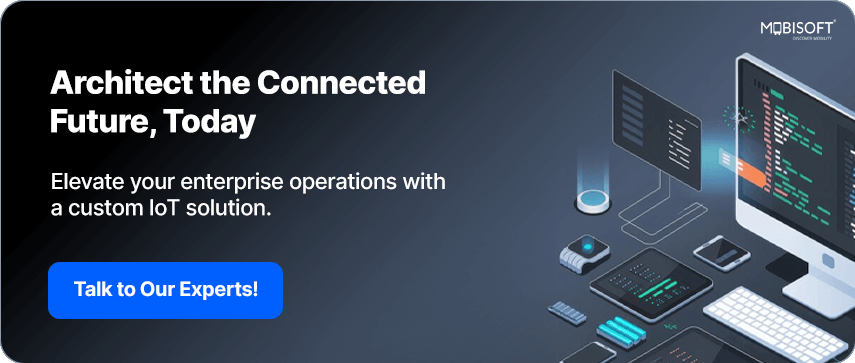
What’s the Current Market Landscape?
The world of IoT mobile solutions is thriving like never before. In 2023 alone, mobile applications generated $489 billion, growing at a fast rate. In just two years, the revenue has gone up by $150 billion, says Coinlaw.
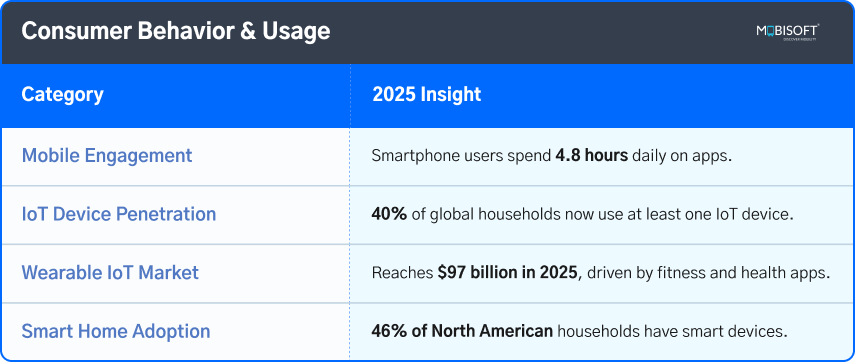
Key Features of Modern IoT Mobile Apps
The latest IoT mobile applications are designed with a user-friendly, customizable UI. They redefine user experience by offering detailed tracking and management:
Real-Time Data Processing and Analytics
IoT apps capture live data to analyze and learn. This enables instant feedback to users and provides smart insights. For example, IoT in healthcare devices can transmit data to mobile apps that track trends over time, helping you make better decisions about your health.
Automation Capabilities
Several applications use this data and adapt to your usage patterns. This means you can schedule actions or define triggers for devices to work automatically. For instance, a lot of smartphones have smart batteries that optimise based on your usage and timings.
Enhanced Connectivity
Transforma Insights reports that short-range technologies such as Wi-Fi and BLE account for 79% of global IoT connections. Bluetooth accounts for 25%, and cellular IoT accounts for about 21%. This diversity of connections enables seamless IoT app integration across industries.
For instance, a lot of smartphones have smart batteries that optimize based on your usage and timings, and robust mobile app maintenance services ensure these IoT apps continue performing reliably over time.
Enhancing User Experience through IoT Integration
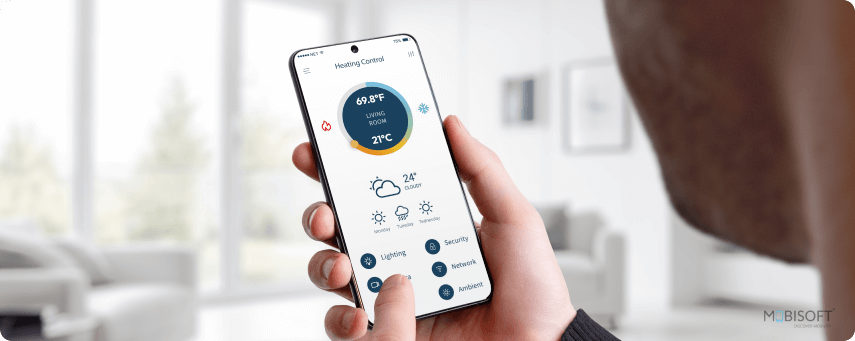
Personalization and Customization
The fantastic thing about IoT mobile apps is the personalization of each experience. They take note of the user's likes and activities and then deliver the user customized solutions.
The fantastic thing about IoT apps for business and consumers alike is personalization. They take note of user preferences and activities, then deliver tailored solutions. For example, smart thermostats analyze the daily routine of the user to adapt and regulate temperature. This not only offers a better experience, but also saves finances.
Mobile App Usage Statistics
The mobile app industry is fluid, and the pace of user engagement is accelerating. Mobile phones are becoming more important every day. User will spend 4.37 hours on their mobile phones daily, suggests the latest research. This brings ample opportunities for IoT app development. Its integration in routine applications will open other closed doors, enriching the user experience.
As of January 2025, there were over 2 million apps on the Google Play Store and nearly 1.9 million on the App Store. Reports also highlight that 90% of mobile engagement happens within applications, creating strong opportunities for IoT mobile apps to scale.
Seamless Connectivity
IoT mobile apps are developed to smoothly connect multiple devices. This ease of access allows users to manage all devices remotely from a single dashboard. IoT in retail, transportation, and smart homes makes use of cloud devices and APIs to offer a seamless experience of a truly connected ecosystem.
Data-Driven Insights
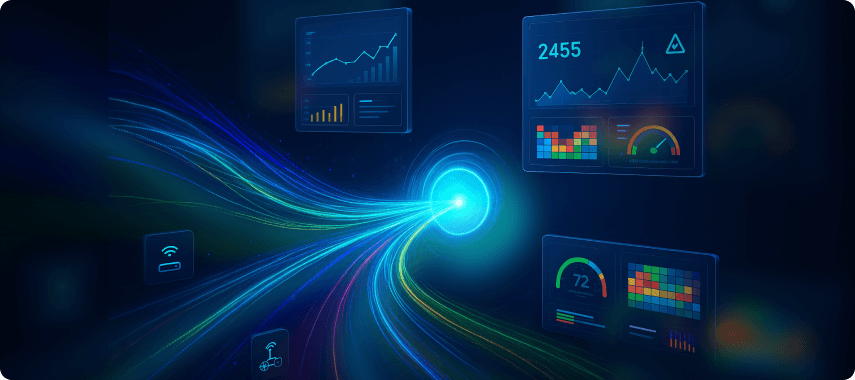
The integration of big data enhances the functionality and overall experience of IoT mobile apps. This is because implementing big data makes apps generate, collect, and analyze data from all the connected devices. As a result, the experience becomes highly personalized, tailored to the user’s needs. A common example is Fitbit, which offers reports and suggestions instead of just raw numbers.
This ability to generate actionable insights demonstrates the benefits of IoT mobile apps for businesses and consumers, proving how IoT apps revolutionize connected ecosystems.
Smooth communication like this is crucial as IoT-powered micro-mobility solutions expand rapidly in retail, transportation, and smart homes.
What’s in it for the CTOs?
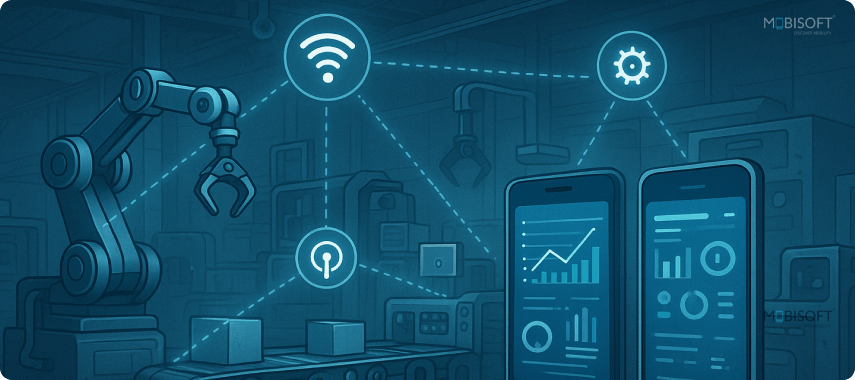
Enterprise Adoption Statistics
Here’s how different industries are adopting IoT solutions:
- In manufacturing, over 35% of companies are using industrial IoT apps to deliver valuable information regarding predictive maintenance, product quality improvements, efficient supply chain management, and more.
- Healthcare providers are close behind, with almost 30% of providers now using IoT in healthcare for remote patient monitoring, enhancing medical devices, and real-time patient health data analysis.
Operational Efficiency with IoT Mobile Apps
Nowadays, a lot of businesses use IoT mobile applications for predictive maintenance to identify machine problems instantly. This enables producers to resolve issues before they become expensive malfunctions. Predictive maintenance has several advantages, such as reduced maintenance expenses, less downtime, and substantial cost savings.
Predictive maintenance of car sensors, for instance, can determine when a car needs to be serviced, which can save maintenance expenses by roughly 10%–40% and breakdown downtime by 30%–50%.
Enhanced Decision-Making with IoT-Driven Mobile Apps
IoT mobile apps for business provide decision-makers with insights that enable companies to make fast, data-driven decisions. As of early 2025, 62% of manufacturers have adopted IoT app development services in their manufacturing or assembly processes, representing a significant rise in adoption rates. Globally, 35% to 46% of factories leverage IoT mobile platforms for predictive monitoring, maintenance, and automation.
Cost Reduction and Scalability in the IoT Ecosystem
The financial aspect of IoT apps is clear. Companies using IoT mobile solutions can reduce costs by up to 30% through operational efficiencies. Along with cost savings, IoT technologies are agile and easily scalable, enabling companies to grow disproportionately without significantly impacting costs.
To implement such scalable solutions effectively, businesses can hire expert mobile app developers who specialize in IoT mobile apps.
Challenges and Security Considerations
Rising Security Threats in IoT Mobile Apps
There have already been 107% more attacks targeting IoT devices and Internet of Things mobile applications weekly in the first five months of 2024 compared to the same period in 2023. These attacks continue to rise. In addition to performance issues, one in three breaches that compromise data include IoT mobile apps as part of failed access points. Financially, IoT security breaches are painful, costing businesses an average of $330,000.
Source: Grand View Research – Smart Cities Market Size & Share, 2025–2030
Common Vulnerability Patterns in IoT Mobile Solutions
Research highlights certain weaknesses in IoT app integration and connected devices:
- Buffer overflow problems make up about 28.25% of issues found.
- Denial of service attacks follow close behind at 27.20%.
Major Security Incidents in 2024
Several high-profile incidents revealed the risks in IoT mobile app security:
- More than 10 million smart TVs, digital projectors, and in-car infotainment systems fell victim to BadBox malware.
- The Roku cyberattack exposed over 576,000 user accounts, shining a bright light on how risky IoT security can be.
Source: Asimily – The Top Internet of Things (IoT) Cybersecurity Breaches in 2025
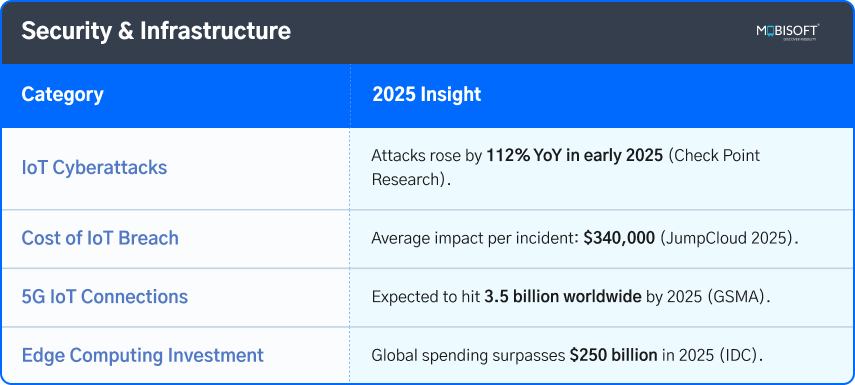
Best Practices for app development
Developers can keep IoT mobile apps safer by following best practices: [1]:
- Data encryption is a must, protecting sensitive information both when it’s stored and when it travels between devices.
- Regularly updating the app and its systems is crucial to defending against new threats.
Source: Fortinet – What Is IoT Security? Challenges and Requirements
Innovations Defining the Next Era of IoT Mobile Apps
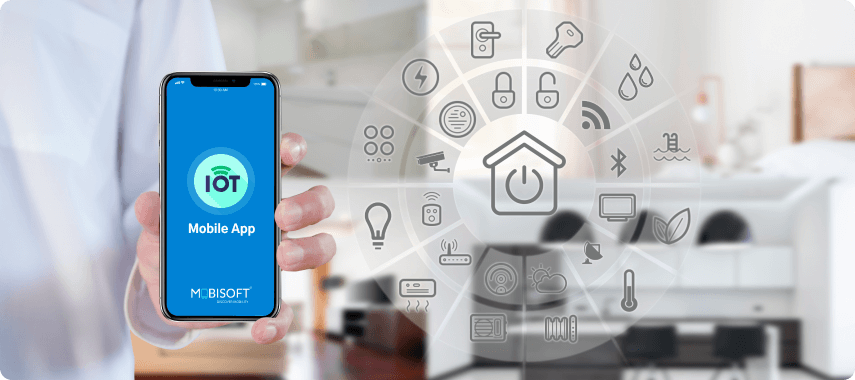
Market Growth Projections
- The global industrial IoT market is expected to reach a remarkable $2,146.07 billion by 2034, growing at a compound annual growth rate (CAGR) of 17.20%.
- The overall IoT app development market is set to hit $356.23 billion by 2034, with a strong CAGR of 18.56%; meanwhile, The 5G and IoT apps segment is anticipated to expand rapidly to $455.67 billion by 2034 at a 50.23% CAGR.
Smart Cities and Sustainability with IoT Mobile Applications
- Smart cities will rely heavily on IoT mobile apps, with the global smart cities market expected to grow from $877.6 billion in 2024 to $3,757.9 billion by 2030 at a CAGR of 29.4%.
- The UK’s smart cities market is projected to nearly double from $1.52 billion in 2024 to $2.63 billion in 2029, while the global urban population is expected to hit 70% by 2050.
AI and Machine Learning in IoT Mobile Apps
- AI and IoT apps are becoming game-changers. In fact, CEOs discussed AI in 34% of Q2 2024 earnings calls, reflecting rising corporate interest.
- The AI in IoT market was valued at $87.51 billion in 2024 and is expected to grow to $161.93 billion by 2034, at a CAGR of 6.35%.
Technology Infrastructure Developments
- 5G adoption soared to 2.17 billion subscriptions in 2024, and this number is expected to reach 5.56 billion by 2030, greatly enhancing IoT connectivity.
- Edge computing gained traction in 2024 with investments from leading semiconductor companies like NVIDIA and AMD, speeding up local data processing and real-time decision-making.
Source: Precedence Research – Internet of Things Market Report
Choosing wisely in 2025
They’re changing the way people engage with technology and driving innovation in enterprises. The numbers are staggering; the global IoT ecosystem will reach over $4 trillion by 2032, with an incredible 40 billion connected devices by 2030. However, with tremendous growth comes challenges. The increase of over 107% in IoT mobile app security attacks in 2024 shows that you can’t ignore security risks in IoT mobile applications.
Looking further ahead, one of the most exciting innovations will come from smart cities, and innovative mobile app development services will play a key role in shaping these IoT ecosystems. With a budget of over $140 billion dedicated to developing sustainable cities, IoT mobile apps for smart homes and offices will represent a substantial portion of this growth. The combination of AI and IoT apps, 5G IoT mobile solutions, and edge computing in IoT will accelerate opportunities for how mobile apps function inside connected ecosystems.
Ultimately, IoT app development services will be successful if they strike the right balance between innovation and security. Users expect supported IoT mobile solutions that are trusted, personalized, efficient, and sustainable. The future is far more than just technology; it’s about building a smarter, safer, and greener future for everyone.
Explore how you can build your own connected ecosystem – hire mobile app developers today!
References
- [1] Fortinet. IoT Security: Strengthening Defenses Against Threats. Retrieved from fortinet.com
- [2] Precedence Research. Internet of Things (IoT) Market Size to Hit USD 356.23 Billion by 2034. Retrieved from precedenceresearch.com
- [3] Asimily. The Top Internet of Things (IoT) Cybersecurity Breaches in 2025. Retrieved from asimily.com
- [4] Grand View Research. Smart Cities Market Size And Share | Industry Report, 2030. Retrieved from grandviewresearch.com
- [5] JumpCloud. IoT Security Risks: Stats and Trends to Know in 2025. Retrieved from jumpcloud.com
Key Takeaways
- Explosive Market Growth: The IoT market is projected to surge beyond $4 trillion by 2032, powered by nearly 20 billion connected devices today, expected to double by 2030.
- Evolution Fueled by Smartphones: From a simple connected toaster in the 1980s to today's advanced IoT mobile apps, smartphones drive global adoption with app revenues soaring from $330 billion to over $530 billion.
- Smart Features Drive UX: Real-time data analytics, automation, enhanced connectivity with Wi-Fi, Bluetooth, and cellular IoT dominate, enabling personalized, seamless experiences.
- Business Impact: Over 60% of manufacturers adopt IoT for predictive maintenance and live inventory control, driving operational efficiency and up to 30% cost reduction with scalable solutions.
- Security Challenges: IoT security attacks rose 107% in 2024, with vulnerabilities like buffer overflow and denial of service prevalent. Strong encryption and regular updates remain essential.
- Future Innovations: Rapid growth will come from smart cities, AI integration, widespread 5G adoption, and edge computing, driving smarter, safer, and greener IoT ecosystems.
- User Engagement: Smartphone users spend nearly 4.5 hours daily on apps, presenting huge opportunities for IoT mobile app integration in everyday life.


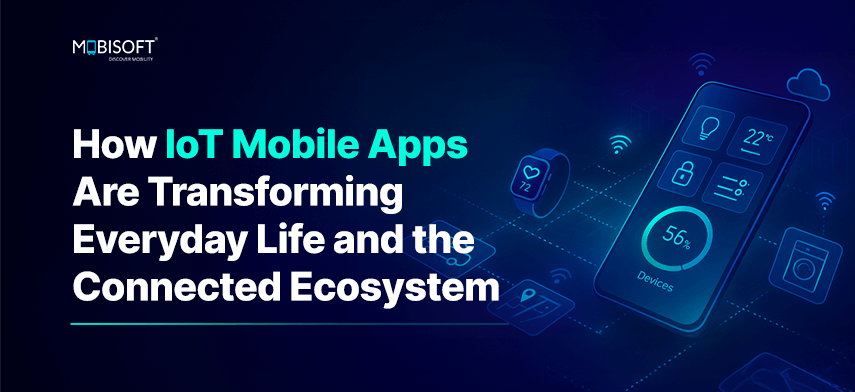


 August 12, 2025
August 12, 2025


